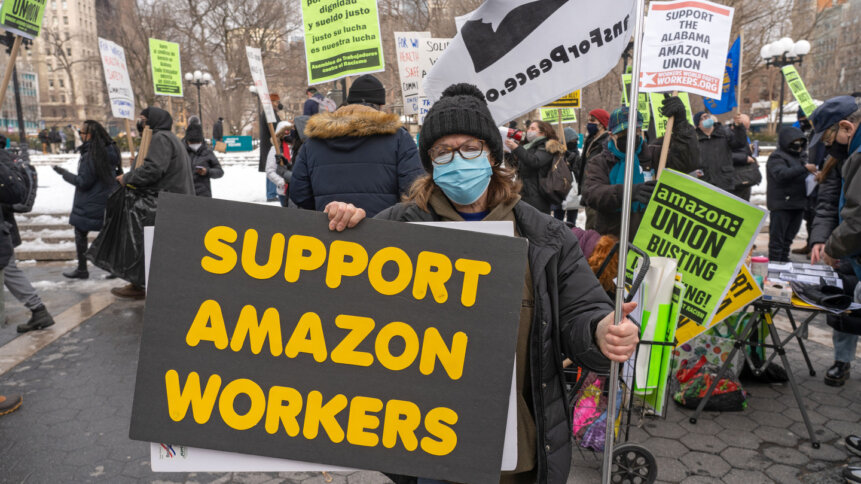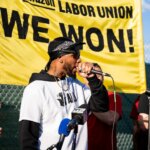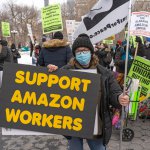Amazon Labor Union suffers major blow in Albany

The fledgling Amazon Labor Union suffered a crushing defeat in its quest to establish its second chapter in Albany, New York this week, after workers at the Amazon workhouse there voted practically 2-to-1 not to unionize.
The votes, which were tallied on Tuesday, gave a 406-206 victory to the company, which has been legendarily anti-union over the course of its existence. The optics of the vote are especially unfortunate for the ALU, as out of four serious attempts to start union chapters in Amazon facilities, the historic JFK8 chapter in Staten Island is now the only success the union has had. So the Albany vote saw 2-to-1 numbers reinforcing a 3-to-1 failure rate to date as far as setting up union chapters in concerned.
An ongoing battle
While union organizer and President, Chris Smalls, told journalists that the Albany vote “isn’t a loss, it’s an ongoing battle,” and said the fight “for fair treatment for all Amazon workers” would “continue and expand,” the convincing anti-union vote in Albany is still being heralded by Amazon as a victory for its “direct negotiation” stance. That’s a stance that has been indicative of much of the tech industry’s view on unionization, which has been equivalent to that of 19th century coalmine and steel foundry owners, but with much better, 21st century PR. The tech industry leaders have always preferred to negotiate from a position of almost lordly advantage, while promoting themselves as part of the cool world of forward-looking knowledge empowerment, creative endeavor, and digital transformation.
In Amazon’s case though, there are significant questions over the company’s hard line approach to unionization.
No smoke without fire
Earlier this month, at the JFK8 facility – the only unionized Amazon facility so far – there was a fire, and unionized workers were told to work on in a building where it was reportedly hard to breathe at some stations because of the continuing stench of smoke. When those workers staged a refusal to work, they were suspended with pay while the company decides what to do about their roles long term. Despite the fact of the ALU’s existence at JFK8, the company has so far refused to acknowledge it, and is still fighting appeals to its initial formation – appeals there is every indication it will lose. The National Labor Relations Board (NLRB) has already thrown out its initial appeal
But nevertheless, being unable to acknowledge the ALU’s power to negotiate on behalf of workers at JFK8, the company suspended the workers, rather than come to an agreement. That, arguably, is what you get when you have a “direct negotiation” policy towards industrial relations.
Amazon is also fighting charges filed by the ALU surrounding events at the LDJ5 warehouse in Staten Island, where the ALU also failed to establish a chapter in May.
Interrogation and reprisals
That allegations include issues around break rooms, and in particular an Amazon rule that staff are not allowed to put up pro-union posters in such areas. As they’re non-work areas, frequented in non-work time, the argument against Amazon runs that it had no legal right to prohibit staff putting up pro-union signs and posters. But there’s more to it than that – the allegations include demands to take the signs down, and the “interrogation” of staff over union activity, including threats of disciplinary action for hanging the posters in the first place.
The NLRB will investigate claims that Amazon then carried out its threats by selective – not to say targeted – use of its solicitation rules (that govern what staff can and can’t do on company property). If the NLRB rules that Amazon acted unlawfully, the ALU may get some comfort – and some support – from the measures it’s likely to enforce on the tech giant. Those are likely to include exemptions for union posters and signage from the solicitation rules, and a lot of employee rights training for supervisors – potentially across the company in the US.
While this has not been confirmed, there are accusations from organizers that Amazon lobbied workers at ALB1 in Albany ahead of the union vote, too, including forcing some to attend anti-union meetings, and even retaliating against workers who tried to rally workers to support the union vote. That wouldn’t be entirely out of character – Amazon fired six pro-union managers shortly after the original JFK8 vote in which the ALU was born.
Last week, the ALU filed for a union election at an Amazon facility in Moreno Valley, California.
Leading the world in everything but workers’ rights
Amazon’s draconian approach to labor relations is particularly ironic – as is that of other tech giants, like Google and Apple, both of which have had their own union battles. That tech companies lead the world in innovation, digital transformation, cloud computing, and business advancement, and yet adopt radically retrograde, 19th century attitudes towards workers’ rights remains a central contradiction at the heart of the industry. With a stream of constant PR pushing the modern, cutting-edge nature of the things it does, the anti-unionization stance of the leading players in the Western technology sector becomes more than a conundrum. It becomes a golden hypocrisy.










